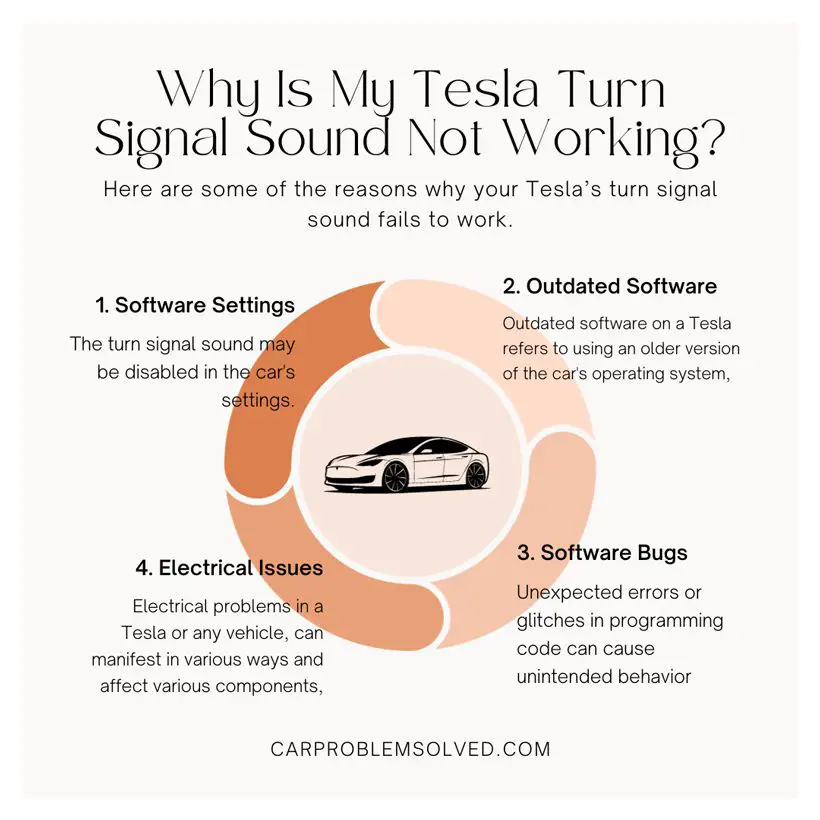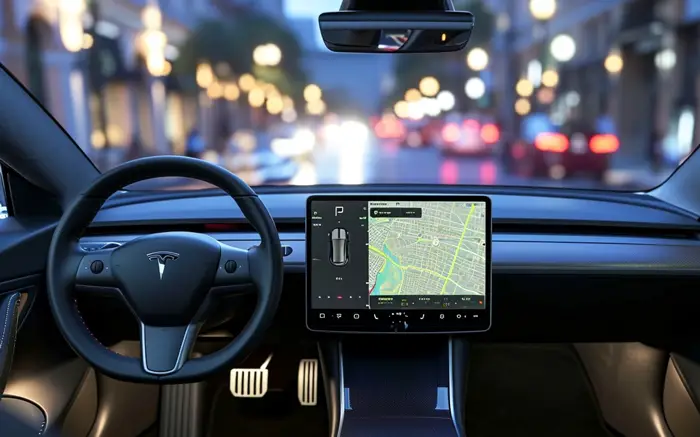Tesla vehicles are known for integrating their cutting-edge technology into the driving experience. However, even the most advanced systems can experience hiccups from time to time. One common concern that Tesla owners may encounter is the unexpected silence of the turn signal sound.
So, why is the Tesla turn signal sound not working? This issue could be because of software misconfigurations, outdated system software, or electrical issues. Other issues include physical damage to the turn signal stalk or malfunctions in sensors or modules.
Understanding and addressing the factors causing the Tesla turn signal sound’s absence is critical. This is because drivers rely on audible signals for safe navigation on the road. Continue reading to know how to resolve this issue.
Why Is My Tesla Turn Signal Sound Not Working?

Here are some of the reasons why your Tesla’s turn signal sound fails to work.
1. Software Settings
The turn signal sound may be disabled in the car’s settings. Check the settings menu to ensure that the turn signal sound is enabled. Here is how to do it.

Solution
- Navigate to Controls: Tap on the “Controls” icon on the bottom row of the touchscreen. This icon typically looks like a steering wheel.
- Go to Vehicle Settings: Within the Controls menu, you will find an option for “Vehicle.” Tap on this option to access settings related to the car’s functions and features.
- Find Turn Signal Sound Settings: Look for an option specifically related to the turn signal sound. Depending on the Tesla model and software version, this might be under a sub-menu within the Vehicle settings.
- Enable Turn Signal Sound: Once you locate the Turn Signal Sound settings, you should see an option to enable or disable the sound. Ensure that the turn signal sound is set to “On” or “Enabled.”
- Save Changes: After making any adjustments, be sure to save or confirm the changes. This is often done by tapping a “Save” or “Confirm” button on the touchscreen.
- Test the Turn Signals: After enabling the turn signal sound, test the turn signals by using the turn signal stalk. You should hear the audible clicking sound indicating the turn signal activation.
2. Outdated Software
Outdated software on a Tesla refers to using an older version of the car’s operating system, firmware, or software applications. Using outdated software can cause various problems, including decreased performance and the failure of certain features, such as the turn signal sound.

Solution
- Connect to Wi-Fi: Tesla vehicles receive software updates via Wi-Fi. To download and install updates, make sure your car is connected to a reliable Wi-Fi network.
- Check for Software Updates: Navigate to the touchscreen menu and select ‘Software.’ Check for available updates by selecting ‘Software Update.’ If an update is available, follow the on-screen prompts to download and install it.
- Scheduled Software Updates: Tesla vehicles can be set to receive software updates automatically. In the ‘Software’ menu, you can enable “Scheduled Software Updates” to allow your car to download and install updates during specific time frames. For example, during the night when the car is parked.
- Contact Tesla Support: If you cannot update the software or encounter issues during the update process, you should contact Tesla support.
3. Software Bugs
Unexpected errors or glitches in programming code can cause unintended behavior in a system including the software running on Tesla vehicles. In the case of the Tesla turn signal sound not working, a software bug could be to blame for disrupting the sound system’s normal operation.
Solution
- Check for Software Updates: Ensure that your car’s software is up to date.
- Reset the Console: Simultaneously press and hold both scroll wheel buttons on each side of the steering wheel. Press them for roughly 10 seconds or until the Tesla “T” emblem displays on the center screen. This will restart your infotainment system and will clear any minor issues.
- Perform a System Reboot: Rebooting the car’s system can help clear temporary glitches. To do this, park the car, go to ‘Safety and Security‘ on the touchscreen, and choose ‘Power Off.‘ After turning the car off, wait for a minute and then turn it back on.
- Contact Tesla Support: If the issue persists after updating the software and rebooting the system, it’s advisable to contact Tesla support. They can provide guidance, troubleshoot remotely, and escalate the issue if needed.
- Log a Bug Report: Tesla vehicles include a system for tracking bug reports. If you encounter a persistent problem, you can file a bug report using the car’s touchscreen. This information is extremely useful to Tesla engineers in diagnosing and resolving software issues.
- Wait for Future Updates: In some cases, software bugs may necessitate a fix in a future software update. Tesla is constantly improving its software, and known issues are frequently addressed in subsequent releases.
Here is a video showing how to solve the issue by performing a soft and hard reset.
4. Electrical Issues
Electrical problems in a Tesla or any vehicle, can manifest in various ways and affect various components, including the turn signal system. When addressing turn signal sound issues, it’s crucial to examine the wiring, relays, and related components. These elements play a vital role in the proper functioning of the turn signal sound.
Common Electrical Issues:
- Malfunctioning Relay: The turn signal system in a car uses a relay to regulate the flashing of the lights and the accompanying sound. A malfunctioning relay disrupts the operation of the turn signal.
- Wiring Problems: Damaged or frayed wiring can interrupt the electrical flow to the turn signal system, preventing the sound from functioning correctly.
- Faulty Connections: Loose or corroded connections within the electrical system impede the proper transmission of signals, affecting the turn signal sound.
- Issues with the Sound-Producing Components: If the sound-producing components, such as the speaker or associated modules, are faulty, it results in a lack of turn signal sound.
- Blown fuses: If the fuse associated with the turn signal system blows, it hinders the electrical flow and prevents the turn signal sound from functioning. Therefore, you should check and replace blown fuses as part of troubleshooting turn signal problems.

Solution
If you suspect that electrical issues are causing the turn signal sound problem, you must seek professional assistance. Tesla service technicians have the knowledge and tools to conduct thorough diagnostics.
While some basic troubleshooting can be done by owners, attempting DIY repairs for complex electrical issues may cause more harm than good. It’s advisable to consult Tesla service professionals for such matters.
FAQs
Here are some other related questions about the Tesla turn signal sound issue.
Issues with turn signal functionality, including sound, are only covered under the vehicle’s warranty if they are the result of manufacturing defects or faulty components. However, if the problem is due to user preferences or adjustments rather than a malfunction, coverage may be denied.
No, “Joe mode” in a Tesla is a feature designed to reduce the volume of certain in-car chimes and alerts. However, it does not affect the operation of turn signals. If the turn signal is not working, it is likely due to other factors, such as software settings, bugs, or potential electrical issues.
Yes, modifications or additions such as third-party accessories or software changes may interfere with your Tesla’s normal operation. If you recently installed aftermarket products or made software changes, return to the original configuration. Observe if the turn signal sound problem still persists.
Conclusion
There’s no need to panic if your Tesla’s turn signal sound doesn’t work. Begin with simple solutions such as checking and adjusting the turn signal sound settings in the vehicle’s menu. If that does not work, reset the console or reboot the vehicle.
Also, ensure you confirm that your Tesla’s software is up to date, as software updates frequently include bug fixes that can address such issues. If these simple fixes do not solve the problem, please contact Tesla’s customer service for professional assistance.

